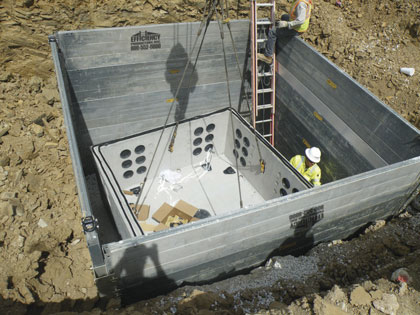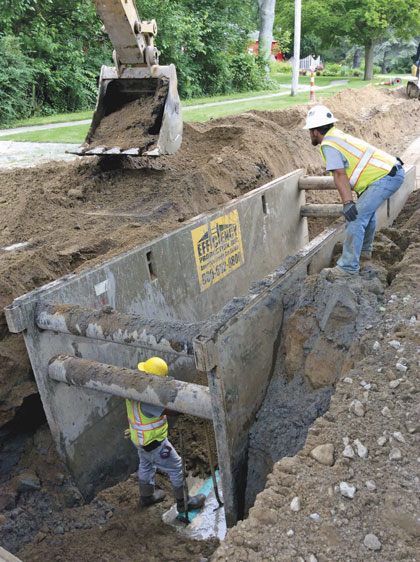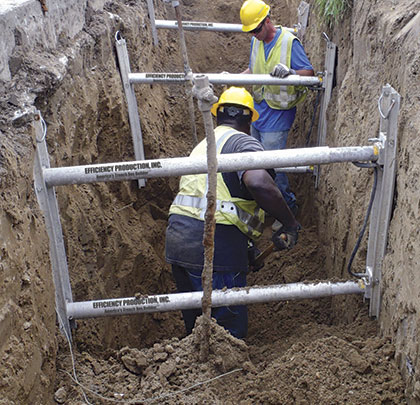This year, the North American Excavation Shoring Association (NAXSA) held its first annual association meeting for trench shoring dealers and manufacturers. NAXSA’s ultimate goal was for the meeting to build relationships and share innovative ideas. “In light of current legislative and regulatory changes, it is essential that we expand our networks and strengthen our existing connections,” says Dana Woudenberg, NAXSA president. “The mission of our new association is to unite our industry while promoting communication, education, innovation, and shared industry-wide goals and standards.”
More than 120 attendees from across the country arrived to participate in the discussions. The meeting was a mixture of fun and games and business talk, with industry professionals sharing best practices and discussing recently released regulations, explaining the impact of proposed regulations on the shoring industry. “Our industry nationally represents over $1 billion worth of business in trench safety. Some of the issues discussed at our Arizona conference were the need to streamline and bring uniformity to the training of correct excavation shoring practices and the issue of when older shoring equipment should be deemed obsolete and unsafe for further use,” says Woudenberg.

Photos courtesy of Efficiency Production, Inc.
MEETING DEBRIEF
Attending the meeting were manufacturers of shoring equipment, companies that rent and sell equipment regionally, and representatives from companies that make and distribute ancillary products used in trench excavation shoring and confined spaces protection. In bringing this group together, NAXSA hoped to gain a better understanding around the different interpretations among rental operators around the country. Dana mentioned the association’s desire to get better uniformity among rental operators supplying shoring equipment for construction projects in the U.S.
“We’ll get involved frequently with projects where the engineer or the owner or contractor has to use a particular type of shoring. There is a lack of information—or a lack of knowledge—about all of the different shoring options and it becomes cumbersome when the plans say ‘you’ve got to build it’ or ‘you’ve got to use this,’” says David Dow, of the NAXSA training committee. “That might be a viable option, but there might be five other viable options as well.” Dow says that much of the confusion stems from lack of knowledge.
However, Woudenberg adds that uniformity in the industry is not the only issue needing clarification. “Right now there exists too many gray areas of interpretation between the OSHA Standards for proper excavation shoring, and the regional engineers’ interpretation of those standards,” Woudenberg explains. “We would like to see those standards tightened up and more clearly defined.”
Jasper Calcara, who is overseeing the drafting of the association’s new engineering guidelines, agrees with Woudenberg. “The OSHA excavation and shoring standards are not black and white,” Calcara asserts. “What you find is different interpretations by different individuals or companies and many people working within those gray areas,” he adds. “There are industry engineers that will be more aggressive and those that will be more conservative with their interpretation of the standards, which can result in more risk for certain companies or individuals.”
In certain circumstances, an excavation contractor does not even need site-specific engineering for a project. Instead, they can abide by the tabulated data that is provided by the shoring equipment’s manufacturer. The tabulated data is a certification that is stamped by a Registered Professional Engineer (R.P.E.) that stipulates how the specific shoring system can be used, such as how deep a trench shield can go in certain soil conditions. As long as the contractor is using the equipment in accordance to the tabulated data, then they are considered in compliance by OSHA. However, even the tabulated data for similar types of shoring can vary greatly between manufacturers, which can cause confusion by the end user for its lack of uniformity.

PLANS AND PROPOSED SOLUTIONS
NAXSA’s next meeting, which is already on the books for mid-February 2016, will take the association back to the Wild Horse Pass Resort & Casino in Chandler, Arizona. The association still has some important topics to cover: “We want to increase the awareness of local contractors, utilities, and municipalities who still today are putting their employees at risk by sending them down into unsafe excavations without proper shoring in place,” says Woudenberg. Safety is an ever-increasing issue in the construction industry and the excavation shoring sector is not exempt.
“We are a relatively small industry to the extent that we can, as an industry, advance our members’ knowledge so that they’re in a position to better serve their customers,” says Dow. Knowing what tools are available to use and for what types of project will better equip those in the excavation shoring industry, in turn abating the confusion and making the work/project environment safer. “I’m always interested in trying to get the group of manufacturers and engineers in this industry to come up with a consistent stance and approach because it would benefit everybody,” says Calcara, regarding a solution to OSHA’s gray area issue.
ABOUT NAXSA
Formed in July 2014, NAXSA promotes safe and effective use of excavation shoring equipment and practices. The idea for NAXSA was drummed up by a group of companies, manufacturers, and regional suppliers of shoring equipment who met at CONEXPO in Las Vegas. “Among the 18 individuals who make up the ‘founders’ are hundreds of years of experience and knowledge in the excavation shoring world,” says Woudenberg. NAXSA’s goal is zero deaths and injuries in the excavation construction industry. ■
For More Information: NAXSA is the national leader in promoting the use of successful and safe excavation shoring practices. For more information, visit www.naxsa.org.
_________________________________________________________________________
Modern Contractor Solutions, October 2015
Did you enjoy this article?
Subscribe to the FREE Digital Edition of Modern Contractor Solutions magazine.

Clarifying Industry Components


